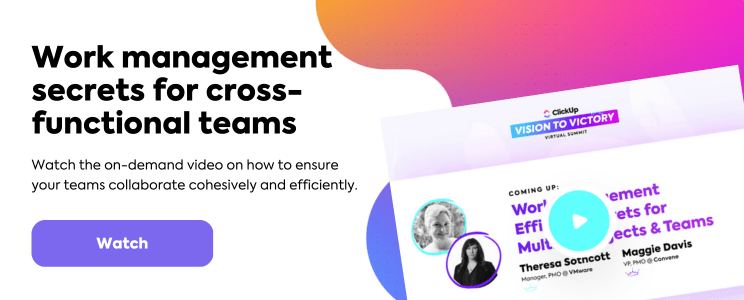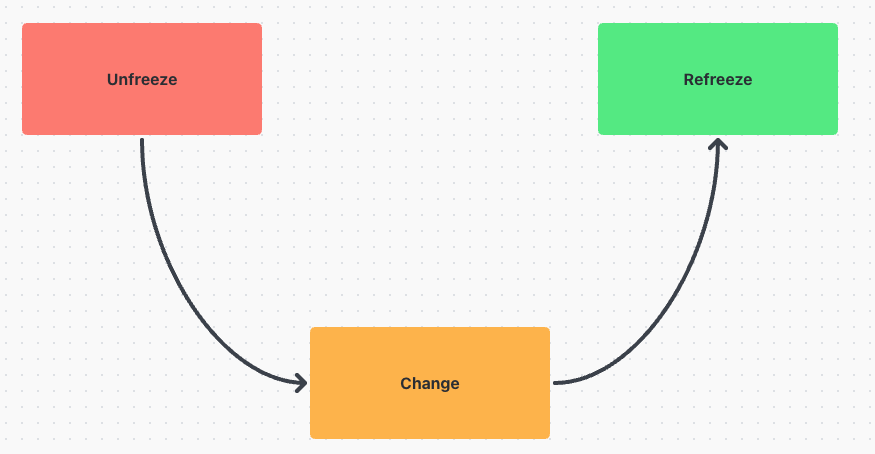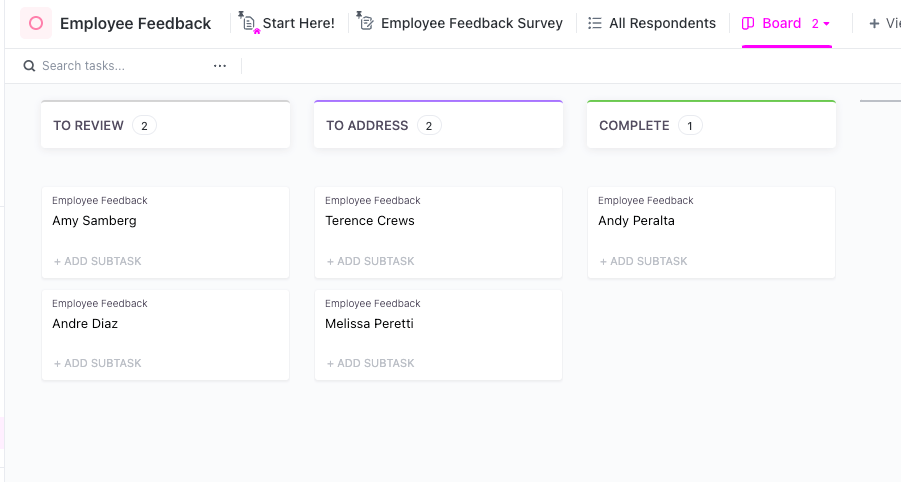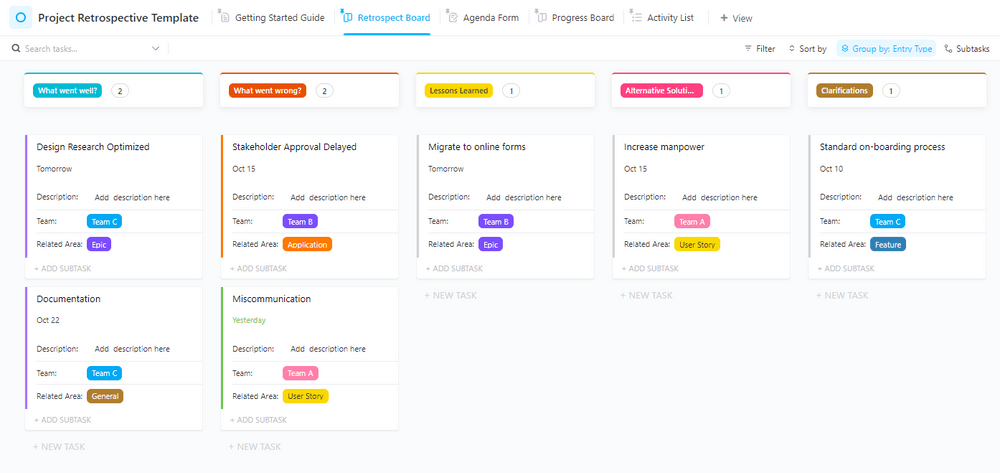What is Change Management? 3 Phases for a Smooth Transition

Sorry, there were no results found for “”
Sorry, there were no results found for “”
Sorry, there were no results found for “”
As an Engagement Manager on the Professional Services team at ClickUp, I’ve helped many customers successfully launch our platform in their organization. You might be surprised to learn that setting up ClickUp is the easiest part of any project.
Planting a strong foundation with a well-built Hierarchy and configuration of meaningful views is important! But the way your organization experiences change can directly impact the success of any digital transformation.
Change management is about facilitating change at an individual level by assessing the needs of your stakeholders and preparing for the change initiative accordingly.
Some business leaders at this point might ask themselves, why bother? Let’s just push through the change management process as quickly as possible and hope for the best.
I’m here to tell you that a little bit of time will help everyone through the change initiatives and will lead to vast benefits.

First and perhaps most importantly, effectively implementing change management helps guarantee your return on investment. It ensures that your people have quick adoption, strong utilization, and proficiency in the product for a successful change.
It also reduces the need to rework or revisit processes, as your stakeholders are very involved in the project from start to finish.
Finally, your change management strategy can assist with meeting your goals and success measures that you have when you first decide on ClickUp as a product. It’s really just insurance to realize the benefits of successful change management.

The change management model from Kurt Lewin assumes for each change an organization goes through cycles through three stages:
The point of implementing this change management process is to move people through the change curve more quickly. Ultimately, business leaders want to reduce the time that is spent in flux and the uncertainty at the bottom of the change curve.
Everyone moves through the change curve at different speeds, so as part of your planning, you’ll need to consider all your different types of stakeholders in your strategic vision. Below we’ll take you through each of the different stages so you can manage change and get through your processes more effectively.
We’ve also put together a Change Management template which includes stakeholder interview questions, a Change Management Plan, and Communications Plan.
This stage of your change management process is all about discovery and planning.
Firstly it’s important to identify the impact of implementing change on your stakeholders, whether directly or indirectly affected. In digital transformation projects, there are three main types of change:
In the case of a ClickUp implementation, the new system is ClickUp! Consider how different the system will be compared to the current state as this can affect how much and what type of training your team needs.
When launching a new system, it’s only natural that the processes or workflows that your team follows will change along with it. Producing Standard Operating Procedures documentation (in Docs!) can be a great resource for your team.

This type of change is probably the one that people are most concerned about during a digital transformation—will the new system replace me? It’s important to consider the impact on your people during organizational change management and clearly communicate expectations.
Once you’ve identified the areas that you feel your team will most be impacted by, it’s time for you to ask them! Conduct stakeholder interviews to ask the members of your team what their main concerns are and identify the organizational change gaps to get back to the status quo.

For example, your team could think that the change initiatives coming to their processes are relatively minor, though your assessment is they are major. This means during the project you’ll need to ensure that you include extra training sessions to bring the team up to speed on how to manage the change.
Also, it might emerge in the interviews that your people are concerned that the new system will lead to redundancies. This would tell you that you’d need to embed strong messaging in your communications plan to address these fears.
If you conduct stakeholder interviews, you’ll soon be able to identify the resistants, skeptics, and champions.
Champions are the people who have already been won over by the change and will be your ambassadors for ClickUp. They may have used ClickUp before or they may just be a very engaged person on your team.
Champions should be used to motivate the rest of the team and be included in the process of implementing ClickUp as subject matter experts.
It’s probably obvious that Resistants are people who are very hesitant about a change initiative or any kind of change. It’s important to acknowledge but limit these people from spreading negative sentiment so the project is not sabotaged. Remember the negativity bias—negativity is louder than positivity.
The final category of people is your Skeptics. These are actually my favorite type of people to be involved in a workshop when I’m gathering requirements for the implementation of ClickUp for project management!
Here you have the most invested people in the outcome of the project and will question processes and change accordingly. They will think of the things that management won’t.
Identify the types of people above and work with them during the project management process or the change initiative, accordingly!
Now that you’ve gathered all this information, it’s time to put it to work! There are two assets I recommend for any successful project with its change management strategy.
Luckily, ClickUp is a great tool to produce and maintain these plans. In our change management template, there are already sample plans there ready for you to use. In your change management strategy, you’ll want to include all the activities that you plan to conduct to help your team adopt ClickUp.
Some of those activities could include:
The communications plan is where you’ll set up tasks for the planned communications that will happen during the change. These can include:
In our template, there is some draft language there for you to use in a lot of these communications. There are a number of features in ClickUp that can help with setting this up too!

I like to add all my planned tasks from my communications plan to the change management plan so I can see a holistic view of everything.

For things like weekly updates and steering committee meetings, use the recurring tasks feature to easily remind you to complete these activities.
The Change phase occurs when the changes are actually taking place. This can be the most tumultuous time for your team, but if you’ve worked hard in the Unfreeze stage you should have a plan in place to get you through this time.
Your biggest challenge during this time is to get everyone through the change curve and prevent anyone from getting stuck. Be prepared to modify your plans in the face of things that come up during the project.

If you’ve put some feedback processes in place like a ClickUp form or a Slack channel, you should start hearing some of these issues that might arise. Your leadership team is also important for monitoring the morale of your team and providing observations.
They’re on the ground with their teams and will have their finger on the pulse of the overall vibe. Below are some reasons that people can get stuck during the change process and how to combat them:
If someone doesn’t understand the purpose of bringing ClickUp or any new system into your organization, they will likely lack engagement during the project and be slow to adopt it. Ensure that you spend time explaining the ‘why’ to your team and get your champions to evangelize the value of a successful change.
Change can be scary!
For those that are afraid of the upcoming change initiative, ramp up your communications and ensure that the process is very transparent. Involve your stakeholders in the change management process to help take away those doubts—and ultimately ensure things will be back to the status quo.
When learning a new system, people can be worried about whether they will have the technical ability to start using it. Ensure that training sessions are scheduled not only for launch but for the weeks and months following. Consistency is crucial to managing change.
Remember the Resistants we identified earlier? If the voices of your Resistants get too loud it can drag the rest of the team down when managing change. Minimize the disruptions by providing private channels of feedback for these people through their managers.
If you’re the JIRA expert on your team and suddenly JIRA is going away, it could make that person very nervous about their own purpose and importance on the team. Involve anyone with these concerns more heavily in the rollout of ClickUp to assuage these fears.
If your team has experienced change before in your organization and it caused a whole lot of upheaval and pain, your team can be nervous about what this next change can mean. You’ll want to acknowledge past issues and speak about the measures being taken to implement lessons learned from previous projects.
In a similar vein, if your organization is constantly going through change people may believe the new system is a temporary fad that will go out of fashion. Emphasize the long-term plans for ClickUp so people know it’s not just the new hot thing.
Be prepared to pivot your plan for any issues that might come up and involve your teams as much as possible when you manage change in this phase. You’ll come through the other side smiling!
The final stage is all about ‘freezing’ the change in place so that ClickUp becomes the new business as usual. This is often the most neglected stage because once the launch happens the project is closed and everyone moves on to the next thing.
I can’t emphasize enough the importance of this stage in encouraging the adoption of ClickUp. Your team has just been through a major transformation and put in a lot of effort—it’s time to recognize that!
Some of the sustainment activities you should include are listed below. The world is really your oyster here and only you will know what best fits the culture of your organization and overall business strategy.
To close out the change, consider holding a post-launch celebration. This can be a great way of signifying to your team that the change period has concluded and also reinforcing the cutover to ClickUp.
The celebration can take many forms, like providing lunch for your team or giving everyone a cupcake. Even short-term wins that come up right away are great to promote when you manage change.
ClickUp also has a really useful reporting widget available in our Dashboards called Workspace Points. This widget will allocate points to people based on the number of tasks they are working on, tasks completed, and comments added.

I’ve seen a number of my successful clients create an internal competition for their people with the person with the most Workspace Points to receive a gift voucher. Implementing this at the launch is a masterstroke because it encourages people to get stuck into ClickUp early on and also migrate all their current work into the system.
The easiest way to find out if your people are embracing the change is to ask them! A few weeks post-launch, survey everyone again to hear their sentiments about ClickUp, feedback, and suggestions for improvements.

There are often edge cases we haven’t thought about during the discovery phase that emerges here and can foster a sense of continuous improvement with the product. You’ll also find out if there are any knowledge gaps that can be addressed with extra training.
If your team is telling you they’re needing extra training, provide it for them! Even if they’re not telling you, it’s worth providing additional opportunities to ask questions and learn more.
The most successful methods of this I’ve seen are things like Office Hours where people can bring their specific ClickUp questions that might not otherwise be addressed in a training session.
On top of that, if you can get your ClickUp champions to present how they use ClickUp in meetings and sessions like Lunch and Learns, you’ll find people picking up the tips and tricks their peers are giving them.
To make sure that the full experience of the change is a positive one, acknowledge your champions and subject matter experts that contributed to the project. It’s a big deal going through a change initiative so reward everyone accordingly.
Organizations: Change is inevitable in businesses. In fact, it’s the only constant. For organizations, a change management plan is key to navigate through transitions smoothly. It shelters the company from potential disruptions and minimizes the losses that could be caused by unmanaged adjustments. This plan can help drive improvement, innovation, and growth within the organization.
Employees: It’s not just the organizations, but also the employees who greatly benefit from a comprehensive change management plan. The unfamiliarity and apprehension that comes with change can often lead to a decrease in morale and productivity among the staff. With a proper change management plan, employees receive essential support and guidance through the transition, reducing resistance and improving acceptance of the new scenario.
Change Management ensures that your team comes through the other side of a ClickUp implementation unscathed. It also encourages adoption and makes sure you get the quickest possible return on investment.
Don’t neglect any of the three stages—Unfreeze, Change, and Refreeze. Preparing for each stage will ensure that you get the most out of your staff and out of ClickUp.
© 2025 ClickUp